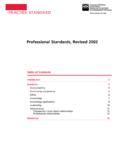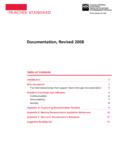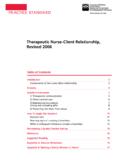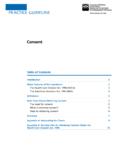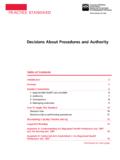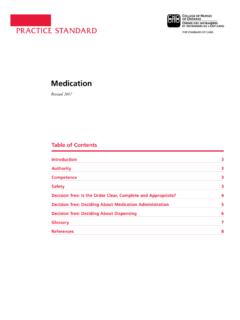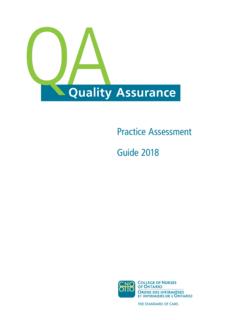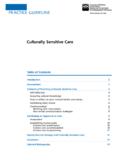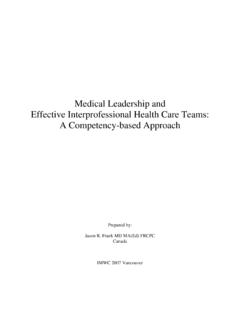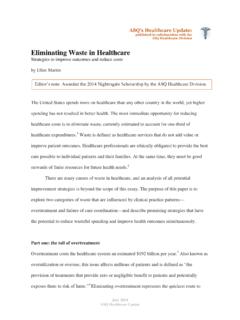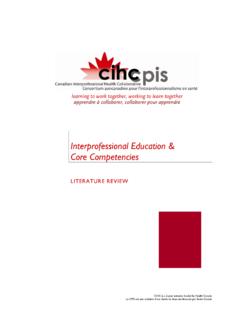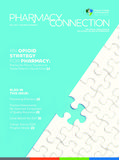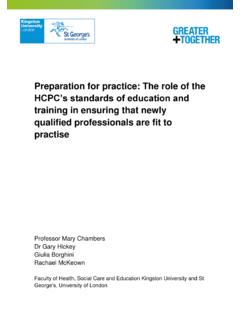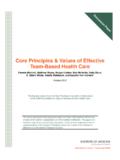Transcription of PRACTICE GIDELINE RN and RPN Practice: The …
1 PR ACTICE GUIDELINE. RN and RPN PRACTICE : the client , the nurse and the Environment Table of Contents Introduction 3. Guiding Principles 3. Legal Scope Of PRACTICE 3. Nurses' Accountability 4. The Three-Factor Framework 5. Client factors 5. nurse factors 7. Environment factors 11. Appendix 12. Glossary 14. References 16. VISION. Leading in regulatory excellence MISSION. Regulating nursing in the public interest RN and RPN PRACTICE : the client , the nurse and the Environment Pub. No. 41062. ISBN 978-1-77116-013-1. Copyright College of Nurses of Ontario, 2014. Commercial or for-profit redistribution of this document in part or in whole is prohibited except with the written consent of CNO. This document may be reproduced in part or in whole for personal or educational use without permission, provided that: Due diligence is exercised in ensuring the accuracy of the materials reproduced;. CNO is identified as the source; and T. he reproduction is not represented as an official version of the materials reproduced, nor as having been made in affiliation with, or with the endorsement of, CNO.
2 First Published June 1996 as A Guide to Health Care Consent and Substitute Decisions Legislation for RNs and RPNs Replaces Publication Published 1997, Determining Appropriate Category of Care Provider First Published July 2002 as PRACTICE Expectations: A Guide for the Utilization of RNs and RPNs, Reprinted December 2002, Revised for Web June 2003, Reprinted January 2004, December 2005, May 2008. Updated June Dec 2011 as RN and RPN PRACTICE : the client , the nurse and the Environment, this document replaces Utilization of RNs and RPNs. Revised 2014 for Dispensing. Additional copies of this booklet may be obtained by contacting CNO's Customer Service Centre at 416 928-0900. or toll-free in Ontario at 1 800 387-5526. College of Nurses of Ontario 101 Davenport Rd. Toronto ON M5R 3P1. Ce fascicule existe en fran ais sous le titre : L'exercice de l'IA et de l'IAA : l'infirmi re, le client et l'environnement, no 51062. 3. PR ACTICE GUIDELINE.
3 PRACTICE guidelines are documents that help nurses decisions about the utilization1 of individual understand their responsibilities and legal obligations nurses in the provision of safe and ethical care to enable them to make safe and ethical decisions when outline expectations for nurses within the three- practising. They provide an outline of professional factor framework, highlighting the similarities accountabilities and relevant legislation. and differences of foundational nursing College of Nurses of Ontario knowledge and its impact on autonomous practice2. Introduction highlight nurses' accountabilities when Nursing is a profession that is focused on collaborating with one another collaborative relationships that promote the best identify attributes of PRACTICE environments possible outcomes for clients . These relationships that facilitate nursing assignments, enhance may be interprofessional, involving a variety of collaboration and lead to improved client health care professionals working together to deliver outcomes and public protection.
4 Quality care within and across settings; or it may be intraprofessional, with multiple members of the Guiding Principles same profession working collaboratively to deliver The following principles guide nurses' PRACTICE quality care within and across settings. expectations and are the basis for decision-making when working within the intraprofessional team: This document focuses on three factors the The goal of professional PRACTICE is to obtain the client , the nurse and the environment to support best possible outcome for clients . nurses in making decisions that are specific to their RNs and RPNs study from the same body of intraprofessional responsibilities when providing nursing knowledge. RNs study for a longer client care. period of time, allowing for greater foundational knowledge in clinical PRACTICE , decision-making, These three factors have an impact on decision- critical thinking, leadership, research utilization making related to care-provider assignment (which and resource management.)
5 As a result of these nursing category (Registered nurse [RN] or differences, the level of autonomous PRACTICE of Registered Practical nurse [RPN]) to match with RNs differs from that of RPNs. client needs), as well as the need for consultation The complexity of a client's condition influences and collaboration among care providers. the nursing knowledge required to provide the level of care the client needs. A more complex Many of the concepts in this document apply client situation and less stable environment create to all nurses; however, references to nurses or an increased need for consultation and/or the intraprofessional care in this document refer only need for an RN to provide the full range of care to RNs and RPNs nurse Practitioners are not requirements. included in this document because the complexity of Respecting and understanding the expectations client care does not define their involvement in care. and contributions of the health care team facilitates appropriate utilization of nurses, This document replaces the Utilization of RNs and enhances collaboration and leads to improved RPNs PRACTICE guideline.
6 Client outcomes. Purpose Legal Scope Of PRACTICE The purpose of this document is to: The Regulated Health Professions Act, 1991 (RHPA). help nurses, employers and others make effective and the Nursing Act, 1991 provide 1 . For the purpose of this document, utilization refers to determining the appropriateness of assigning client care to nurses, and of nurses accepting responsibility for client care. 2. Bolded words are defined in the glossary on page 14. College of Nurses of Ontario PRACTICE Guideline: RN and RPN PRACTICE : the client , the nurse and the Environment 4. PR ACTICE GUIDELINE. the legislative framework for nursing PRACTICE . b eyond the point in the nasal passages where Components of the legislative framework are a they normally narrow scope of PRACTICE statement and a list of controlled beyond the larynx acts authorized to nursing. beyond the opening of the urethra beyond the labia majora Controlled acts are activities that are considered beyond the anal verge, or to be potentially harmful if they are performed into an artificial opening in the body.
7 By unqualified persons. A profession's legal scope dispensing a drug of PRACTICE is determined by its scope of PRACTICE statement and the controlled acts it has the There are differences between RNs and RPNs'. authority to perform. authority to initiate controlled acts. Initiation refers to independently deciding that a specific procedure Members of regulated health professions are within a controlled act is required, and performing authorized to perform specific controlled acts that procedure in the absence of an order. For more appropriate to their profession's scope of PRACTICE . information, refer to the Decisions About Procedures Having the authority to perform a procedure and Authority, PRACTICE document at does not necessarily mean that the individual is docs. competent or that it is appropriate for the individual to perform the procedure. Nurses' Accountability Nurses show accountability by taking responsibility i. Nursing's Scope of PRACTICE Statement for their decisions and actions, taking appropriate The scope of PRACTICE statement describes in a action when needed and ensuring that PRACTICE is general way what the profession does and the consistent with entry-to- PRACTICE competencies, methods that it uses; it refers to the profession as a standards of PRACTICE , guidelines and legislation.
8 Whole, rather than what any individual can do. Nurses are expected to consult with others when The scope of PRACTICE statement for nursing states: any situation is beyond their competence. A nurse is not accountable for the actions and decisions of The PRACTICE of nursing is the promotion of health other care providers when the nurse has no way of and the assessment of, the provision of, care for, and knowing of those actions. the treatment of, health conditions by supportive, preventive, therapeutic, palliative and rehabilitative The nurse is accountable for: means in order to attain or maintain optimal function. her or his actions and decisions knowing and understanding the roles and PRACTICE is so broad and varied that no one nurse responsibilities of other team members, and is expected to be competent to carry out all the collaborating, consulting and taking action on activities within the legal scope of PRACTICE ; hence, client information when needed the notion of full scope of PRACTICE is unlikely.
9 Taking action to ensure client safety, including informing the employer of concerns related to the ii. Controlled Acts Authorized to Nurses conduct and/or actions of other care providers, The Nursing Act, 1991 authorizes nurses to perform and the following controlled acts: collaborating with clients , with each other and performing a prescribed procedure below the with members of the interprofessional care team dermis or mucous membrane for the benefit of the client . administering a substance by injection or inhalation The designated nursing authority (which is the putting an instrument, hand or finger: nurse with the highest level of authority for nursing beyond the external ear canal in the PRACTICE environment) is accountable for College of Nurses of Ontario PRACTICE Guideline: RN and RPN PRACTICE : the client , the nurse and the Environment 5. PR ACTICE GUIDELINE. ensuring there are mechanisms in place such as 2. Predictability: policies, procedures, guidelines and other resources the extent to which a client's outcomes and future to support the following: care requirements can be anticipated.
10 Utilization decisions that take into account client, nurse and environment factors, and that are 3. Risk of negative outcomes: evidence-based the likelihood that a client will experience a nurse collaboration and consultation negative outcome as a result of the client 's health clear and well-understood role descriptions condition or as a response to treatment. professional nursing PRACTICE , and continuity of client care. Client continuum The three client factors described above combine The Three-Factor Framework to create a representation of the client that can be Making effective decisions about which nursing placed on a continuum. The continuum goes from category (RN or RPN) to match with client less complex, more predictable and low risk for needs involves considering three factors of negative outcomes, to highly complex, unpredictable equal importance: the client , the nurse and the and high risk for negative outcomes. (See chart environment, and deliberating on how they apply to below.)
